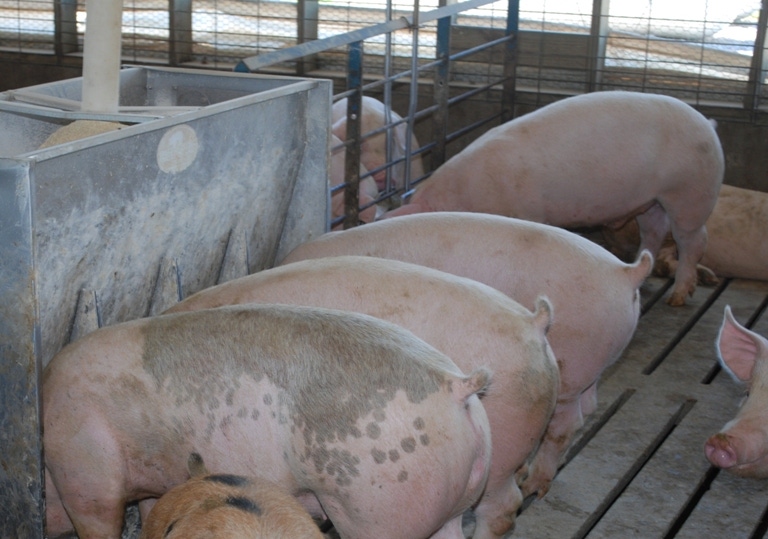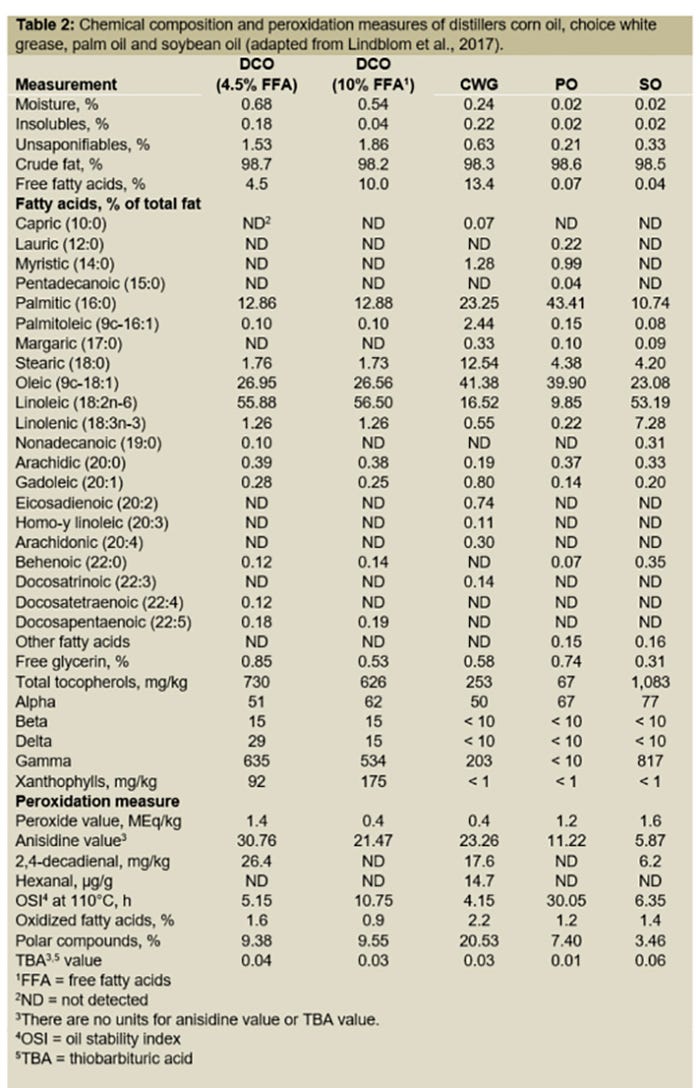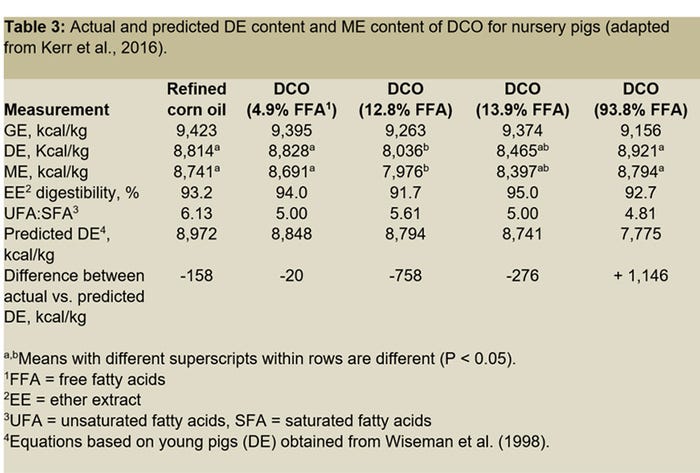Need better understanding of energy levels in distillers corn oil
Part 8 in the series “What have we learned about feeding DDGS to pigs over the past 20 years?”
January 21, 2019

By Jerry Shurson, University of Minnesota Department of Animal Science; and Brian Kerr, USDA- Agricultural Research Service National Laboratory for Agriculture and The Environment
More than 90% of fuel ethanol plants in the United States are separating corn oil from thin stillage to produce distillers corn oil. In 2017, about 3.6 billion pounds of DCO was produced by the U.S. ethanol industry, with about half of this total production being used to produce biodiesel while the other half is marketed as a high-quality energy source for use in poultry and swine diets.
The abundant supply of DCO, its high metabolizable energy content, and relatively low price compared with other feed fats and oils make it an attractive energy source to use in commercial swine diets. The market price of DCO is closely related to the price of yellow grease in the U.S. fats and oils market, but DCO has substantially greater ME content than yellow grease, and while the ME content is comparable to that in soybean oil, soybean oil is more expensive. Some U.S. poultry and pork market segments have chosen to produce chicken and pork by feeding only “vegetable-based” diets (which include vegetable oils) to meet specific consumer demands as part of their marketing strategies.
Furthermore, the perceived risk of pathogenic virus transmission from adding porcine-derived feed ingredients to swine diets in the United States has led some veterinarians and nutritionists to remove these ingredients (e.g. choice white grease, animal byproduct protein meals), and replace them with only plant-based ingredients (e.g. corn, soybean meal, distiller’s dried grains with solubles and distillers corn oil). Up until recently, the use of DCO in swine diets has generally been limited to the nursery and early grower phases because feeding high concentrations of corn oil reduces pork fat firmness. A reduction in carcass fat firmness can reduce bacon yields, may reduce shelf life of fresh pork products and negatively affects pork quality acceptability in the Japanese export market.
However, now that a Generally Recognized As Safe approved commercial feed additive is available and effective in preventing reductions in pork fat firmness when feeding growing-finishing diets containing high amounts of unsaturated fatty acids from vegetable oils (i.e. DDGS and DCO), concerns about the use of high diet inclusion rates of DDGS and DCO are minimal. In 2016, the Association of American Feed Control Officials (2017) developed and approved the official definition for DCO for use in animal feeds as follows:
“33.10 ____ Distillers Oil, Feed Grade, is obtained after the removal of ethyl alcohol by distillation from the yeast fermentation of a grain or a grain mixture and mechanical or solvent extraction of oil by methods employed in the ethanol production industry. It consists predominantly of glyceride esters of fatty acids and contains no additions of free fatty acids or other materials from fats. It must contain, and be guaranteed for, not less than 85% total fatty acids, not more than 2.5% unsaponifiable matter, and not more than 1% insoluble impurities. Maximum free fatty acids and moisture must be guaranteed. If an antioxidant(s) is used, the common or usual name must be indicated, followed by the words “used as a preservative.” If the product bears a name descriptive of its kind of origin, i.e. “corn, sorghum, barley, rye,” it must correspond thereto with the predominating grain declared as the first word in the name.” Proposed 2015, Adopted 2016 rev. 1)
Installments in the DDGS series
Part 1: 20 years of DDGS lessons in pig diets
Part 2: Varied energy and digestible amino acids levels in DDGS manageable
Part 3: Work continues to evaluate performance responses from feeding DDGS
Part 4: Managing carcass yield, pork fat quality when feeding corn DDGS
Part 5: Reaching an understanding of fiber characteristics of corn DDGS
Part 6: Enzymes, pre-treatment improve fiber and nutrient digestibility
Part 7: DDGS show greater antioxidant capacity than in corn grain
Part 8: Need better understanding of energy levels in distillers corn oil
Chemical composition of distillers corn oil
One of the distinguishing features of DCO compared with refined corn oil is that many DCO sources have greater free fatty acid content (Table 1), which can range from less than 2% to as much as 18%. Previous studies evaluating various feed lipids have shown that increasing FFA content reduces ME content for pigs and poultry, and as a result, led to the development of DE (swine) and AMEn (poultry) prediction equations (Wiseman et al., 1998). Corn oil is distinguishable from animal fat sources because of its relatively high polyunsaturated acid (PUFA) content, especially oleic (9c-18:1; 28 to 30% of total lipid) and linoleic (18:2n-6; 53 to 55% of total lipid) acid content. Vegetable oils have greater PUFA content than animal fats, which results in vegetable oils having greater ME content (Kerr et al., 2015). As a result, DCO contains one of highest ME concentrations of all feed fats and oils in the market, but it is also more susceptible to oxidation during thermal processing and storage (Kerr et al., 2015; Shurson et al., 2015; Hanson et al., 2015). Feeding oxidized lipids to pigs and broilers has been shown to reduce growth rate, feed intake and gain efficiency (Hung et al., 2017), and highly oxidized corn oil reduces efficiency of energy utilization and antioxidant status in nursery pigs (Hanson et al., 2016).

However, the addition of commercially available antioxidants to DCO have been shown to be effective in minimizing oxidation of DCO when stored at high temperature and humidity conditions (Hanson et al., 2015). Although the extent of oxidation (peroxide value, anisidine value and hexanal) in DCO is somewhat greater than in refined corn oil, it is much less than in the oxidized corn oil fed to nursery pigs in the study by Hanson et al. (2016), where reductions in growth performance were observed.
A comparison of the chemical composition and oxidation indicators of two commercially available DCO sources with choice white grease and refined palm oil, and soybean oil is shown in Table 2. Choice white grease (rendered pork fat) consists primarily of oleic acid (9c-18:1), palmitic acid (16:0) and stearic acid (18:0), which results in this lipid source being classified as a saturated fat source compared with DCO. In general, saturated animal fats (i.e. choice white grease) have less ME content than more unsaturated vegetable oil sources (i.e. DCO). Because choice white grease contains a greater proportion of saturated fatty acids than DCO, it is less susceptible to lipid oxidation than DCO, but the temperature and heating time used during rendering can result in a similar amount of peroxidation compared with DCO (Table 2). The predominant fatty acids in refined palm oil are palmitic (16:0) and oleic (9c-18:1) acid, and the linoleic acid content (9.85%) is much less than found in DCO (56%).

As a result, palm oil is much more resistant to oxidation, as indicated by a high oil stability index, compared with DCO, choice white grease and refined soybean oil (Table 2). In contrast, the fatty acid profile of refined soybean oil was similar to that of DCO, and contained high concentrations of linoleic acid (53%), with moderate concentrations of oleic (23%) and palmitic (11%) acids. However, unlike DCO, soybean oil contains relatively high concentrations of linolenic acid (18:3n-3), which makes it more susceptible to oxidation than DCO. Because the soybean oil source evaluated in this study was refined compared with feed grade sources, it contained a lower concentration of aldehydes (products of oxidation), as measured by anisidine value and 2,4 decadienal, compared with DCO, choice white grease and palm oil. Compared with choice white grease and refined palm oil, DCO contained relatively high concentrations of total tocopherols (626 to 730 milligrams per kilogram) and xanthophylls (92 to 175 milligrams per kilogram; Table 2). Only soybean oil had greater total tocopherol content than DCO, but soybean oil is essentially devoid of xanthophylls. Tocopherols and carotenoids (xanthophylls) are strong antioxidant compounds that may be beneficial in reducing oxidative stress in pigs fed diets containing highly oxidized DDGS to nursery pigs (Song et al., 2013).
Therefore, the high tocopherol and xanthophylls content of DCO may be a “value-added” feature and incentive for its use in swine diets to reduce oxidative stress, but more research is needed to explore this potential benefit.
Actual and predicted digestible and metabolizable energy content of distillers corn oil sources for swine
Two studies have been conducted to determine the digestible energy and ME content of DCO for swine. The first study was conducted by Kerr et al. (2016) to determine the DE and ME content of refined corn oil (0.04% FFA), three sources of commercially produced DCO with FFA content ranging from 4.9 to 13.9%, and an artificially produced high (93.8%) FFA corn oil source. In addition, the effect of FFA content on ME content of DCO sources was evaluated.
As shown in Table 3, the ME content of DCO samples ranged from 8,036 to 8,828 kilocalories per kilogram, with the 4.9% FFA DCO sample containing similar ME content compared with ME content of refined corn oil. The ME values for refined corn oil (8,741 kilocalories per kilogram), 4.9% FFA DCO (8,691 kilocalories per kilogram), and 13.9% FFA DCO (8,397 kilocalories per kilogram) were similar to the value of 8,570 kilocalories per kilogram for corn oil reported in National Research Council (2012). Surprisingly, the 93.8% FFA corn oil source had the lowest GE content, but the highest DE and ME content of all corn oil sources.

With the exception of the 12.8% FFA DCO source having the lowest ME content of all sources, there was no significant detrimental effect of FFA content on DE or ME content of DCO. The accuracy of using of prediction equations developed by Wiseman et al. (1998) to predict the DE content of DCO sources was also evaluated to determine if these prediction equations are applicable to DCO sources to provide more dynamic and accurate DE estimates based on variable FFA composition of DCO sources (Table 3). The Wiseman et al. (1998) equations use FFA content, unsaturated to saturated fatty acid ratio, and age of pig as the inputs to estimate DE content. Unfortunately, the results from using these equations showed that DE content was overestimated in refined corn oil and the 12.8% and 13.9% FFA DCO sources, but provided a similar estimate of DE content for the 4.9% FFA DCO source, and greatly underestimated (1,146 kilocalories per kilogram) the DE content of the experimentally produced high FFA DCO source.
These results suggest that the prediction equations developed by Wiseman et al. (1998) need to be reassessed to improve its accuracy and precision of predicting fats and oils not used it their development, such as for DCO.
In a subsequent study, Lindblom et al. (2017) determined the DE and ME content of two different DCO sources (4.5% and 10% FFA), and compared these values with commercially available sources of choice white grease, palm oil and soybean oil (Table 4). The ME values obtained for both DCO samples were substantially less (7,921 and 7,955 kilocalories per kilogram) than the values obtained for two of the three DCO sources (8,397 to 8,691 kilocalories per kilogram) previously evaluated by Kerr et al. (2016). It is unclear why there was a difference in ME content of DCO sources between these two studies, but these results provide further support that FFA content of DCO does not appear to affect ME content for swine. It was also surprising that the ME content for choice white grease (8,535 kilocalories per kilogram) was greater than the ME content of both DCO samples, and was also greater than the NRC (2012) value of 8,124 kilocalories per kilogram, because it is well documented that unsaturated lipid sources have historically had greater lipid content than saturated fat sources (NRC, 2012). However, it is possible that the widespread use of high dietary inclusion rates of DDGS in U.S. growing-finishing pig diets may have resulted in a shift toward more unsaturated fatty acid content in choice white grease obtained from carcasses of these pigs. Evidence for this is supported by the greater linoleic acid content (16%) of this source of choice white grease compared with linoleic acid content of (11.6%) reported by NRC (2012). Furthermore, there was a slight decrease in palmitic acid (23%) in this source of choice white grease compared with 26% palmitic acid reported in the NRC (2012). In addition, the ME content of the soybean oil source evaluated by Lindblom et al. (2017) was substantially greater (9,408 kilocalories per kilogram) than the value of 8,574 kilocalories per kilogram reported by NRC (2012). These results show the potential risks of over- or under-estimating ME content of feed fats and oils when using static values from reference databases.

Conclusion
Distillers corn oil is produced in abundant quantities by the U.S. ethanol industry, is competitively priced, but has variable ME content among sources that does not appear to be associated with its free fatty acid content. New prediction equations need to be developed, or existing equations need to be modified to more accurately estimate the DE and ME content of DCO for swine, because using previously developed equations result in significant overestimation of actual DE content. The relatively high concentrations of tocopherols and xanthophylls may also provide significant antioxidant value when DCO is added as a supplemental energy source to swine diets, but more research is needed to determine if these potential benefits are achieved under commercial production conditions.
References
AAFCO. 2017. Association of American Feed Control Officials — Official Publication. Champaign, Ill.
Hanson, A.R., P.E. Urriola, L. Wang, L.J. Johnston, C. Chen, and G.C. Shurson. 2016. Dietary peroxidized maize oil affects the growth performance and antioxidant status of nursery pigs. Anim. Feed Sci. Technol. 216:251-261.
Hanson, A.R., P.E. Urriola, L.J. Johnston, and G.C. Shurson. 2015. Impact of synthetic antioxidants on lipid peroxidation of distiller’s dried grains with solubles and distiller’s corn oil under high temperature and humidity conditions. J. Anim. Sci. 93:4070-4078.
Hung, Y.T., A.R. Hanson, G.C. Shurson, and P.E. Urriola. 2017. Peroxidized lipids reduce growth performance of poultry and swine: A meta-analysis. Anim. Feed Sci. Technol. 231:47-58.
Kerr, B.J., W.A. Dozier III, and G.C. Shurson. 2016. Lipid digestibility and energy content of distillers’ corn oil in swine and poultry. J. Anim. Sci. 94:2900-2908.
Kerr, B.J., T.A. Kellner, and G.C. Shurson. 2015. Characteristics of lipids and their feeding value in swine diets. J. Anim. Sci. Biotechnol. 6:30.
Lindblom, S.C., W.A. Dozier III, G.C. Shurson, and B.J. Kerr. 2017. Digestibility of energy and lipids and oxidative stress in nursery pigs fed commercially available lipids. J. Anim. Sci. 95:239-247.
NRC. 2012. Nutrient requirements of swine. 11th rev. ed. Natl. Acad. Press, Washington, D.C.
Shurson, G.C, B.J. Kerr, and A.R. Hanson. 2015. Evaluating the quality of feed fats and oils and their effects on pig growth performance. J. Anim. Sci. Biotechnol. 6:10.
Song, R., C. Chen, L. Wang, L.J. Johnston, B.J. Kerr, T.E. Weber, and G.C. Shurson. 2013. High sulfur content in corn dried distillers grains with solubles protects against oxidized lipids by increasing sulfur-containing antioxidants in nursery pigs. J. Anim. Sci. 91:2715-2728.
Wiseman, J., J. Powles, and F. Salvador. 1998. Comparison between pigs and poultry in the prediction of dietary energy value of fats. Anim. Feed Sci. Technol. 71:1-9.
You May Also Like



